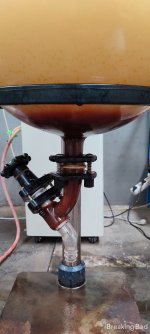- Joined
- Nov 10, 2022
- Messages
- 72
- Reaction score
- 152
- Points
- 33
I will share the table with you.

- Joined
- Feb 22, 2023
- Messages
- 270
- Reaction score
- 186
- Points
- 43
I will share the table with you.
View attachment 7998
Keep it below 180, better below 175°C and calibrate the Infrared thermometer to the flask/setting you use or you will never exactly know how hot it is.
Good luck
↑View previous replies…
OrgUnikumBut how many minutes, 30 minutes like it states or 10 minutes divided in three portions at 60w? 150 - 160C?
I want to try this synthesis, since I have a colleague who happens to have a microwave reactor
@G.Patton @William Dampier Any input on this?
ZACARIASKLK123I attach the article and you can look for yourself. I saw a post elsewhere where somebody claims good yields like 80% in a modified household microwave(hole for condenser) with temperatures not over 175°C to avoid Formamide decomposition. No further details were given on this.
- Joined
- May 10, 2023
- Messages
- 17
- Reaction score
- 10
- Points
- 3
Maybe it is just fair to add that temperatures over 180 °C like the named 200 and 210 °C for sure completely destroy P2P and even the Formamide, the resulting vapors and gases are highly toxic. Vent everything coming from top of the condenser outsides! Seriously!
Keep it below 180, better below 175°C and calibrate the Infrared thermometer to the flask/setting you use or you will never exactly know how hot it is.
Good luck
- 15minutes total?, because I have read some did that.
I want to try this synthesis, since I have a colleague who happens to have a microwave reactor
@G.Patton @William Dampier Any input on this?
- Or perhaps The end of the reaction is determined when the gases cease to be released?
Last edited:
- Joined
- Feb 22, 2023
- Messages
- 270
- Reaction score
- 186
- Points
- 43
But how many minutes, 30 minutes like it states or 10 minutes divided in three portions at 60w? 150 - 160C?
- 15minutes total?, because I have read some did that.
I want to try this synthesis, since I have a colleague who happens to have a microwave reactor
@G.Patton @William Dampier Any input on this?
- Or perhaps The end of the reaction is determined when the gases cease to be released?

